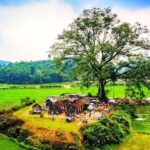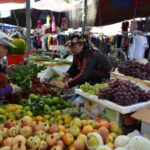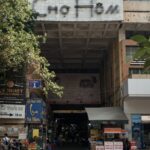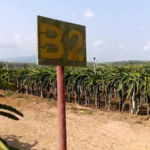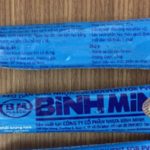The natural landscape here boasts a harmonious beauty, with majestic mountains and lush green terraces surrounding it. Visitors are often captivated by the peaceful and pristine atmosphere, reminiscent of the idyllic countryside.
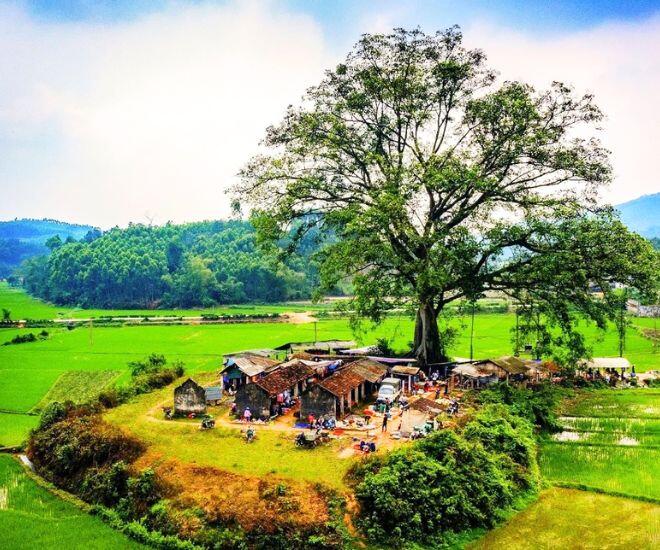
According to observations from many tourists, the central banyan tree of the market shows signs of aging, with one large branch broken due to a lightning strike during a storm. Nevertheless, the locals and visitors alike cherish the primitive beauty and historical value of this tree as a witness to the area’s history.
A Hundred-Year-Old Market’s Historical Journey
Tuân Lộ Banyan Tree Market has a long history, closely associated with the Tay and Dao ethnic groups’ pioneering of the Sơn Dương land. Locals share that the market has existed for hundreds of years, initially serving as a small exchange point for agricultural produce among families in the village.
As time passed and the region’s transportation and economic systems developed, the Tuân Lộ Banyan Tree Market gradually expanded and became a significant periodic market for the entire area. It is held on the 2nd, 7th, 12th, 17th, 22nd, and 27th of every lunar month, starting early in the morning and lasting until noon.
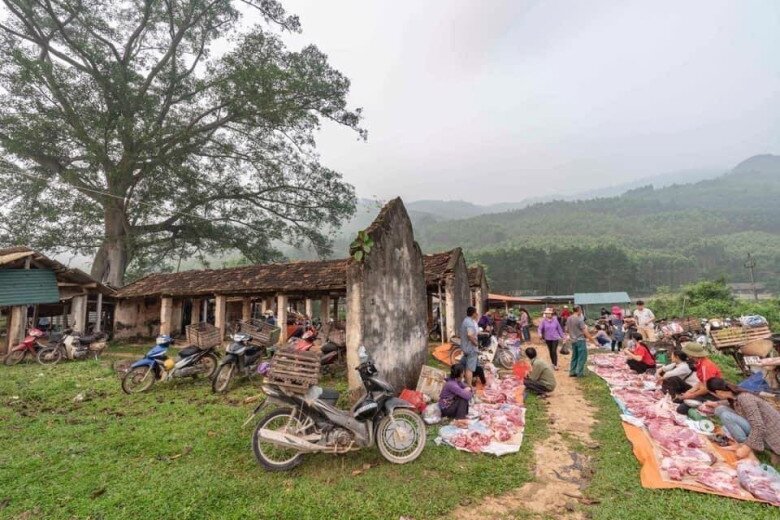
Despite enduring various challenges over time, including the recent Covid-19 pandemic, which led to a noticeable decline in visitors, the Tuân Lộ Banyan Tree Market has resiliently preserved its primitive nature, steering clear of excessive commercialization often seen in other tourist markets.
Rustic Specialties Unique to the Countryside
The most crucial attraction of the Tuân Lộ Banyan Tree Market lies in its diverse range of local specialties, reflecting the characteristics of the mountainous region of Tuyên Quang.
Agricultural Produce and Handicrafts
Strolling through the market, visitors will encounter stalls selling fresh wild vegetables such as rau sắng and rau ngót rừng—unique flavors of northern Vietnam rarely found in urban markets. Additionally, local tubers like khoai sọ, sắn dây, and măng le are on offer, sourced directly from the surrounding forests.
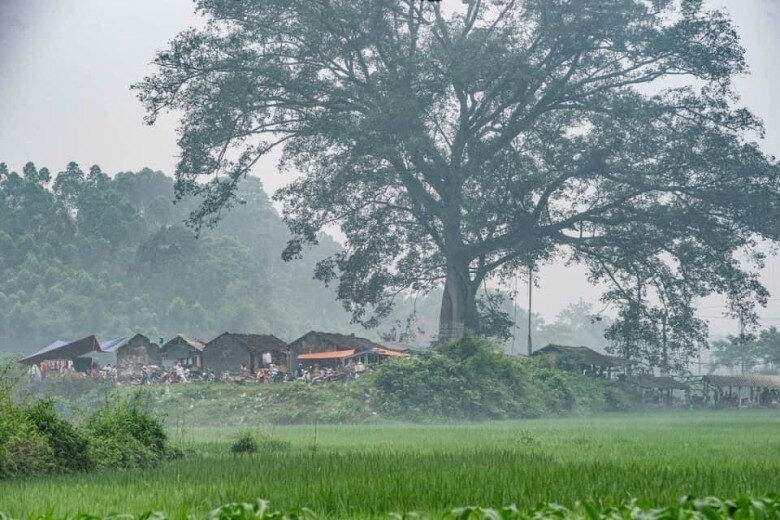
Notably, pure forest honey and spices such as hạt dổi and mắc khén are highly sought-after items. These spices are not only local specialties but also essential ingredients that impart distinctive flavors to ethnic dishes.
Beyond agricultural products, the market showcases and trades handicrafts like sedge mats, brocade bags, and bamboo-made utensils. These items not only cater to the daily needs of locals but also serve as meaningful souvenirs for visitors.
Distinctive Cuisine
The cuisine at the Tuân Lộ Banyan Tree Market embodies the essence of the mountainous region, featuring rustic yet captivating dishes. Visitors can indulge in colorful xôi ngũ sắc, the fragrant thịt trâu gác bếp, and cơm lam—a traditional rice dish cooked in bamboo tubes, imbued with the flavors of the forest.
Grilled stream fish is a specialty not to be missed. Caught from nearby streams, the fish is marinated with simple spices and grilled over charcoal, served with lá mắc mật herbs, resulting in an unforgettable flavor.
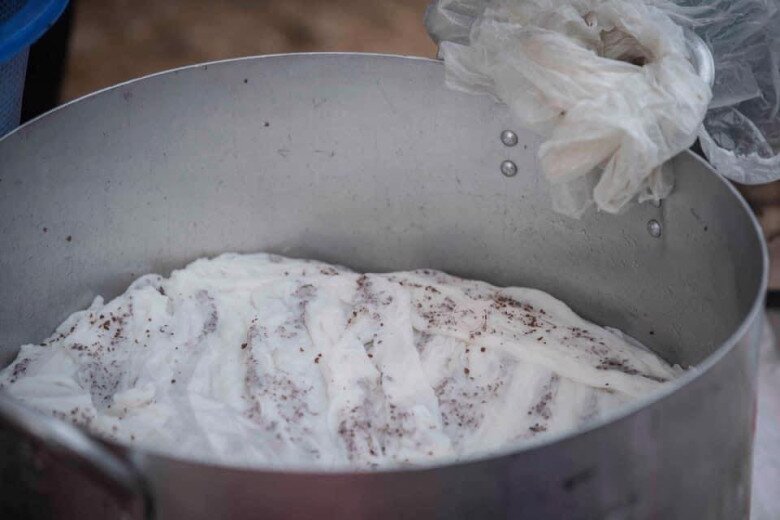
As you wander through the market, you’ll also come across street foods like bánh đúc nóng, a rice flour-based dish served with a sweet and sour fish sauce and topped with crunchy peanuts. Chè lam, a sweet treat made from glutinous rice flour, malt, and peanuts, is another popular snack among visitors to the market.
A Time Capsule Experience: Travel Back 30 Years
Owing to its pristine beauty and rich cultural atmosphere, the Tuân Lộ Banyan Tree Market has been hailed as the “most beautiful periodic market in Vietnam,” attracting interest from both domestic and international travelers.
Visitors flock to the Tuân Lộ Banyan Tree Market not merely for shopping but also to immerse themselves in the local culture. The market’s setting, nestled amidst picturesque natural scenery and bustling trade, paints a charming rural landscape that captivates photographers eager to capture its unique moments.
The natural light filtering through the banyan tree’s canopy, combined with the colorful stalls and the honest faces of the highland people, creates captivating portraits and landscapes imbued with ethnic cultural identity.
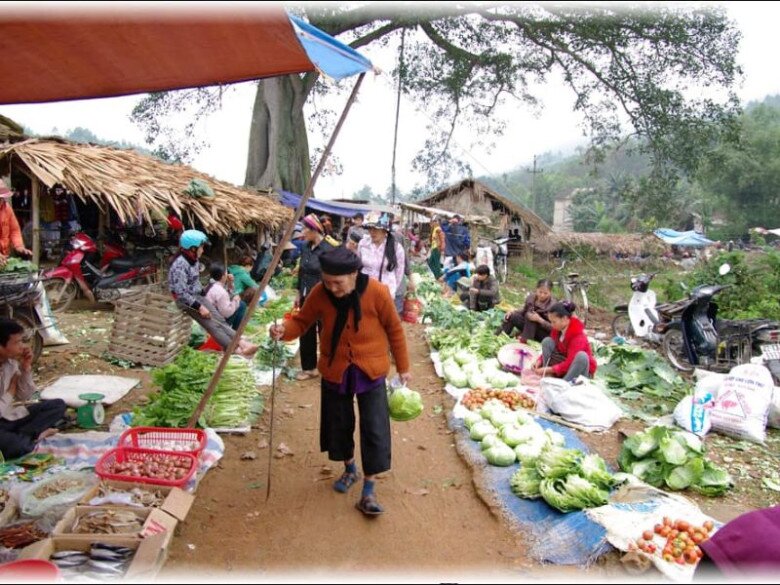
At the market, visitors have the opportunity to engage in various experiential activities, such as learning farming skills and harvesting vegetables or preparing dishes alongside locals. These experiences not only bring joy but also foster a deeper understanding of the highland people’s lifestyle and culture.
During festivals, the market organizes traditional folk games like tug-of-war and stick pushing, along with performances of hát then and đàn tính, the distinctive folk art form of the Tay ethnic group. These activities contribute to a vibrant atmosphere and help preserve traditional cultural values.
Another special experience is visiting the ancient banyan tree, the market’s symbol. Despite being partially damaged by weather conditions, the tree remains a vital spiritual emblem for the locals. Visitors can listen to the legend of the “walking banyan tree,” a folk tale explaining the phenomenon of the tree’s moving roots over centuries.
Practical Tips for Visitors
Ideal Timing: For a comprehensive experience, visitors should arrive at the market early in the morning, between 5 and 7 a.m., when the atmosphere is at its liveliest, and all the goods are on display. The markets on the 2nd and 7th of the lunar month tend to be busier, offering a wider variety of products.
Shopping Tips: When shopping at the Tuân Lộ Banyan Tree Market, visitors should be aware of a few tips to ensure a positive experience. Haggling is a traditional part of the market culture, so feel free to negotiate gently. However, it’s advisable to check prices at several stalls before making a purchase to get a sense of the going rates.
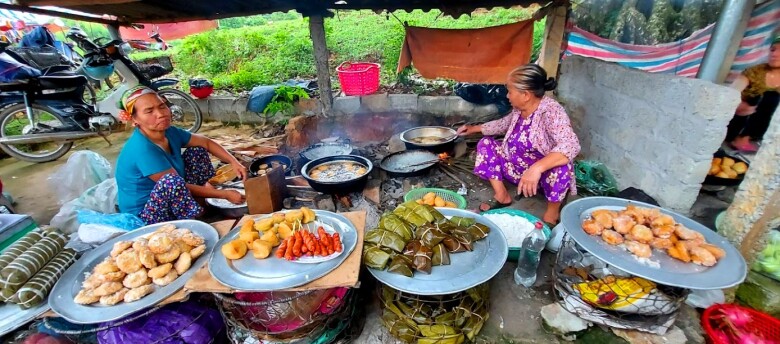
For local specialties like forest honey and thịt trâu gác bếp, which are popular choices for souvenirs, it’s essential to inspect the products carefully and check for proper labeling to avoid counterfeits or low-quality items.
Another valuable suggestion is to take the time to chat with the elderly locals. Their stories will not only provide insights into the region’s history and culture but also offer a deeper understanding of the spiritual life of the highland dwellers.
Preserving Traditional Values
Amid rapid urbanization and the rise of modern trade channels, the Tuân Lộ Banyan Tree Market faces challenges in sustaining its operations and preserving traditional values. The recent Covid-19 pandemic also significantly impacted the market, resulting in a notable decrease in vendors and customers.
However, thanks to the local government’s efforts and the community’s commitment to preserving their cultural heritage, the market has maintained its authenticity and resisted excessive commercialization. This makes it an ideal destination for travelers seeking an unadulterated glimpse into Vietnam’s cultural richness, free from artificial embellishments.
The conservation and sustainable development of the Tuân Lộ Banyan Tree Market contribute not only to the preservation of Tuyên Quang’s vibrant cultural heritage but also to the promotion of the province’s unique tourism attractions to domestic and international visitors. This invaluable asset deserves recognition and emphasis in the local tourism development strategy.
The Tuân Lộ Banyan Tree Market, a melting pot of culinary delights and cultural traditions from the highlands of Tuyên Quang, awaits visitors eager to explore and immerse themselves in the distinctive cultural space of northern Vietnam.
Tuyên Quang also boasts another breathtaking destination that travelers shouldn’t miss: the enchanting Na Hang.
The Heart of Tuyen Quang: A Glimpse into Vietnam’s Most Charming Rural Market
Nestled under the canopy of a centuries-old banyan tree, the Tua Lu Multi-century Market in Tan Thanh Commune, Son Duong District, Tuyen Quang Province has become an iconic cultural landmark in the northern mountainous region of Vietnam. With a history spanning hundreds of years and set against a backdrop of majestic natural scenery, this market is not just a hub for trade but also an emerging tourist destination that has captured the interest of many.
The Market in Hanoi’s Bustling District: An 80-Year Legacy of Selling a Single Specialty
Hanoi’s vibrant marketplace culture is a fascinating aspect of the city’s rich history and heritage. Still thriving today, Cho Hom Duc Vien is not just a bustling local market but also a living testament to the capital’s unique trading traditions. A visit to this market offers a glimpse into the past and a chance to discover the authentic shopping experience of Hanoi’s locals. With its blend of vibrant commerce and cultural significance, Cho Hom Duc Vien promises an intriguing exploration for those seeking to understand the city’s traditional way of life.
The Ultimate Guide to the Top 5 Leak-Proof Plumbing Adhesives
“Pipe adhesives are a handyman’s secret weapon when it comes to plumbing emergencies. With the right adhesive, you can quickly and efficiently repair leaks and prevent further damage. Join us as we explore the top 5 pipe adhesives that are guaranteed to stop those pesky leaks and keep your plumbing system in tip-top shape!”

























